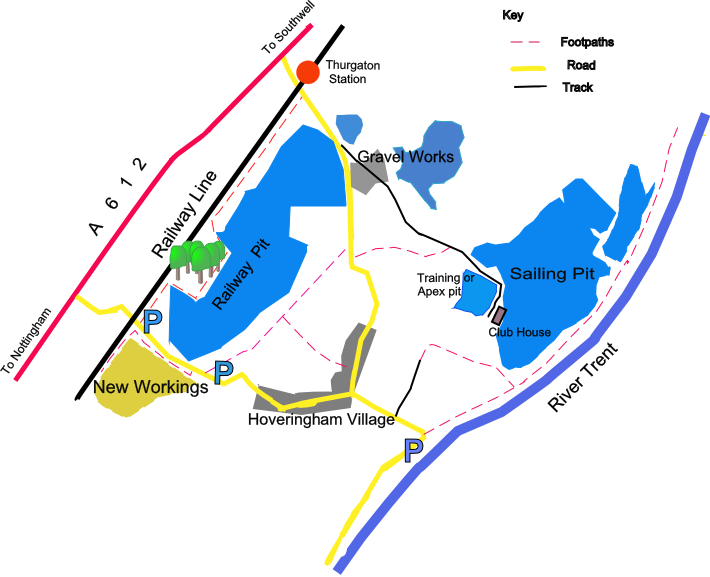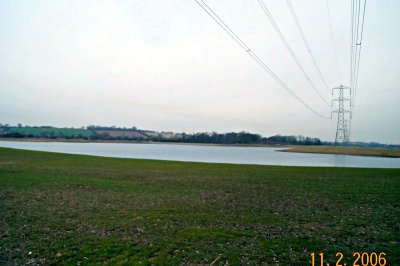
Gravel extraction was started in this area in 1939, by the Hoveringham Gravel company, which was taken over in 1982 by Tarmac. The Hoveringham Gravel Company used to have a mammoth as their logo on their lorries as a celebration of the finding of mammoth remains in their workings.
It's the policy of the district council (Newark & Sherwood) not to automatically insist on reclamation back to agricultural use, mainly because of the lack of suitable "fill". So it looks as if the 'holes' in the ground will be around for some time yet, in one form or another.
Gravel and sand extraction in this area finished in 2007.

The Hoveringham gravel pits lie to the north and east of Hoveringham Village. They are reached off the A612 Nottingham to Newark road. There is no designated parking area close to the pits. Car parking consists of using the grass verges.
The site can be reached easily by rail. The smart looking Thurgaton railway station on the Nottingham to Lincoln line, is the closest, being on the pit's doorstep.
Bus services: Nottingham City Transport services 100,101,201 provide a 3 times an hour service Mondays - Saturdays along the main road between Nottingham and Southall. On Sundays and Bank Holidays the service 201 provides a limited service. Other smaller companies provide a service through Hoveringham Village.
Access is by public footpaths off the Gonalston to Hoveringham road (limited Parking), Hoveringham Railway station (very limited Parking) and by the River Trent. Parking by the sailing club is not advisable as it means passing through a couple of gates which can be locked without warning.
Railway footpath Runs by the Nottingham to Newark railway and gives good views over the west pit and the Railway pit. Access is either off the Hoveringham to Gonalston road with some limited parking, or by the railway station (some very limited car parking here off the road). This path allows reasonable coverage of the north side of the new workings, passes by a small wood, and follows the northern side of the railway pit and meeting the public road close to the railway station.
South Footpath Can park on the roadside verge on the Gonalston to Hoveringham road to access this path. Passes the south end of the new workings, giving good views, with the sun behind. Also this path follows the course of a stream and passes some nice Oak trees. Here and further along are open areas, some "improved pasture" and some uncultivated rough area, good for pipits, wagtails and finches, with arable fields to the south. Further along this path on the left are several horse paddocks which are good for thrushes at the right time of year. This path crosses the Thurgaton to Hoveringham road and continues to the north of the sailing pit to Gibsmere. Just past the Thurgaton to Hoveringham road the path goes through a "sun-trap" an area of scrub almost surrounded by trees which can be excellent for warblers and flycatchers at the right time of year.
River Path On the Hoveringham to Caythorpe road, park by the river on the verge. At weekends in the fishing season be sure to have all four wheels off the tarmac, as the police are very keen along here. Head down stream through the gate and enter the pasture which is now a SINC (Site of Importance for Nature Conservation) because it is typical of a grazed Trent meadow, a habitat now rare. Pass through the gate at the otherside. A path now runs left and gives views over the Sailing Pit. The path by the river carries on to to Bleasby.
 A mature gravel pit with little surrounding vegetation. Called the sailing pit for obvious reasons. Main attraction over the past few years, has been the gull roost, which exists from September to March, where numbers can approach 10,000 birds at the turn of the year, the main species are, Black headed Gull, Common Gull (from January), Lesser black backed Gull (til December) and Herring Gull. Individuals of Kittiwakes, Little Gull, Yellow-legged Gull, Glaucous Gull, Iceland Gull and Mediterranean Gull occur from time to time. As well as gulls there is a winter Cormorant roost. Rarities for the pit include, Ring-necked Duck in 2001, Slavonian Grebe and immature Gannet in 2002, Great northern Diver and two Black necked Grebes in 2006.
A mature gravel pit with little surrounding vegetation. Called the sailing pit for obvious reasons. Main attraction over the past few years, has been the gull roost, which exists from September to March, where numbers can approach 10,000 birds at the turn of the year, the main species are, Black headed Gull, Common Gull (from January), Lesser black backed Gull (til December) and Herring Gull. Individuals of Kittiwakes, Little Gull, Yellow-legged Gull, Glaucous Gull, Iceland Gull and Mediterranean Gull occur from time to time. As well as gulls there is a winter Cormorant roost. Rarities for the pit include, Ring-necked Duck in 2001, Slavonian Grebe and immature Gannet in 2002, Great northern Diver and two Black necked Grebes in 2006.

Until 2004 at least, some of this pit was pumped dry and was a good passage wader habitat, past records include birds such as American Golden Plover. Now flooded and popular with diving wildfowl such as Coot, Goldeneye and Goosander. Notable birds in the recent past include Water Pipit, Smew, Red-necked Grebe and Black-necked Grebe. Peregrines can some times be seen here in the winter often perched on the pylons which pass through the site. The sides of the pit have been graded and still remain open with little vegetation.
Mainly Oak with Ash trees. Contains the expected species, Bullfinch, Chaffinch — could be worth exploring more.
The last pit to be extracted on the west side of the Gonalston to Hoveringham road. There is limited viewing from the footpath with runs from the road, along the minnow filled stream and then by the railway. At least one of the banks was a Sand Martin colony. A Wood Sandpiper was present here for a few weeks in the autumn of 2006. This was the last good passage wader habitat around here and was gone by 2008.
Little Grebe, Little ringed Plover, Ringed Plover, Common Tern, Sand Martin, Tufted Duck, Yellow Wagtail, Reed Warbler, Tree Sparrow, Yellow Hammer, .
Great northern Diver, Slavonian Grebe, Black necked Grebe, Smew, Peregrine, Jack Snipe, Fieldfare and Redwing.
In the winter gull roost on the Sailing pit most birds are Black headed Gulls but with the chance of much rarer birds like Glaucous.
Green Sandpiper, Greenshank, Little Egret, Black Tern, Meadow Pipits and Wagtails.
Any criticisms, corrections or comments to the author Derek Huskisson

This work is licensed under a Creative Commons Attribution-Noncommercial-Share Alike 2.0 UK: England & Wales License.